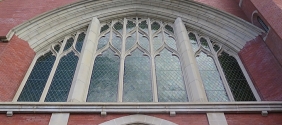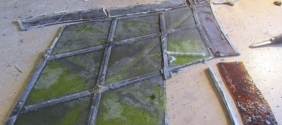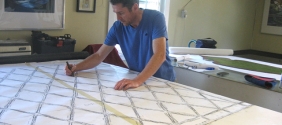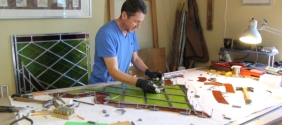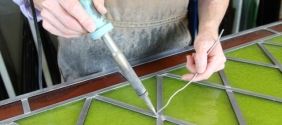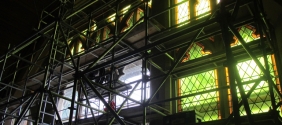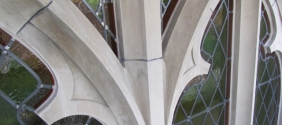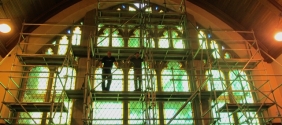The restoration of the historic Great West Window at First Presbyterian Church, Edmonton, Alberta, was an exciting and challenging project. The window is over 100 years old and, at approximately 700 square feet, is the largest leaded window in Alberta. The seven main windows and eighteen traceries were in a very fragile condition, mostly holding together only because they were so tightly pinned into the stonework. The restoration entailed complete removal from the stonework of all the sections, transportation back to our studio in Vancouver where it was painstakingly dismantled, the original glass preserved and cleaned, and the whole window restructured, rebuilt and ultimately reinstalled.
There are many stages to a restoration project that are different to creating a new window, while other stages are the same such as traditional leading and soldering using European quality lead came. One of the most important differences is creating rubbings of the window in its original condition to record shape, width of lead came, individual position and condition of each piece of glass. We always maintain as much of the original glass as possible, but where the damage was too extensive we had to find a match to the 100 year old glass. We sent samples to the largest distributors on the East and West coasts of N. America, who between them cover most of the manufacturers in Europe as well as those closer to home. We found a beautiful hand cast glass which was very close to the original for both colour and refraction of light.
It is unusual here in Canada to install stained glass into stone, which was just one of the reasons we were so well qualified for this project. Our training in the UK meant that we have created and restored windows for many stone buildings; John has worked extensively at Wells and Gloucester Cathedrals. The Great West Window was originally installed with some very unusual and creative methods, so part of the challenge was to restructure it for correct weight distribution using “lap” leads and brass support bars as is done in England and to install it using a stone-mix rather than putty or silicone as is most often done here. It was imperative to use a tried and tested material that would have the necessary longevity for the future, so we sent samples of the stone over to the UK to get a custom stone-mix created to match perfectly.
On the last day of installation, when everything was completed, it was so rewarding to step back and see the Great West Window back in its rightful place, restored to more than its former glory.

